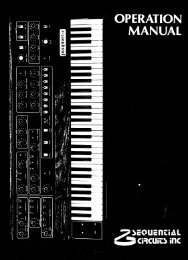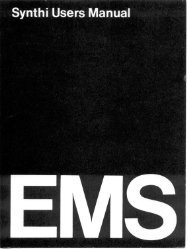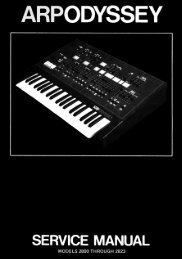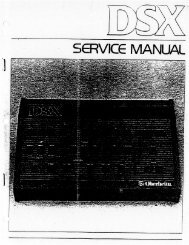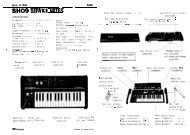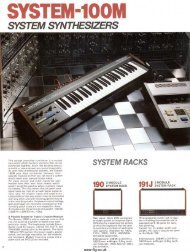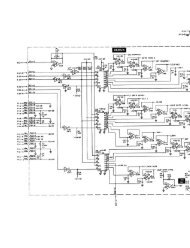ARP2600 - Fundamentals of Music Technology - Cyborgstudio.com
ARP2600 - Fundamentals of Music Technology - Cyborgstudio.com
ARP2600 - Fundamentals of Music Technology - Cyborgstudio.com
Create successful ePaper yourself
Turn your PDF publications into a flip-book with our unique Google optimized e-Paper software.
116 - SECTION FOURTEEN: PATCH DIAGRAMMING AND ANALYSISAbove and beyond all <strong>of</strong> this, the keyboard’s LFO is elbowing into the picture, adding some vibrato ata slow speed. There will be a long delay between the time the key is pressed and the time this vibratobe<strong>com</strong>es apparent, however.The VCA’s gain is being modulated by the AR generator, which is set for a very short attack andrelease. These settings are mirrored in the ADSR generator, which is controlling the VCF. It seems thatthis patch is going to consist <strong>of</strong> short bursts <strong>of</strong> sound as the EG’s momentarily open and close both theVCF and VCA.VCF appears to have another source controlling it’s cut<strong>of</strong>f, however. This patch <strong>com</strong>es from the lagprocessor, whose slider is set to about 1/3 open, which translates to about 1 second <strong>of</strong> lag, perhaps a bitmore. The lag processor’s input has the envelope follower normalled to it. The envelope follower hasits level raised this time, and the preamp has been patched to its input. This is a redundant patch, andshould throw up a red flag for test-taking purposes that someone is going to great trouble to convincethe reader that this patch is authentic. In this particular patch, there is even a level set on the preamp,although nothing is connected to it, so all in all, it is just one very long dead end. This brings up animportant point: If something is not drawn on a patch sheet, do not assume it is there.STEP THREEIn this patch, there is very little left to examine, but the patch deserves looking over one more time.Upon closer inspection, one can see that the S/H GATE switch has been moved to its lower position, sothat the keyboard will no longer trigger the EGs and now the internal clock will cause the EGs to fire.This makes sense, because the clock is going at a fairly fast rate, and a long attack or release timewouldn’t have much effect on the VCA and VCF, so they had to be kept short. Many times, differentparts <strong>of</strong> a patch will reinforce each other and make it obvious that the reader is on the right track. Ifthings seem to conflict or contradict each other, stop and question the authenticity <strong>of</strong> each signal beingfollowed.One final item is the resonance level on the VCF. Normally, this could help to create a filter sweepsound, but the filter is going to be opening and closing too quickly to perceive an actual sweep. Instead,this level <strong>of</strong> resonance will produce a rather bubbly, rounded tone.SUMMING UP PATCH TWOIf one was asked to describe the sound <strong>of</strong> patch two, one might say that patch two is a duophonic patchwith a sawtooth timbre with some noise and a bit <strong>of</strong> the high-frequency ring modulation peekingthrough. The pitch will continually rise and fall, but will do so in steps rather than a continuous smearin frequency. If the keyboard is played, vibrato will be introduced after a few moments, but the internalclock is causing the EGs to fire in short bursts, which are rather ‘burbly’ because <strong>of</strong> the resonance.Finally, the sound pulses on and <strong>of</strong>f in time with the S/H module because the electronic switch isswitching between the patch and silence. This sound can be heard on CD track 82. Again, if anythingseems unfamiliar or unclear about the explanation <strong>of</strong> this patch, take a few moments to go back into theappropriate section to review.




